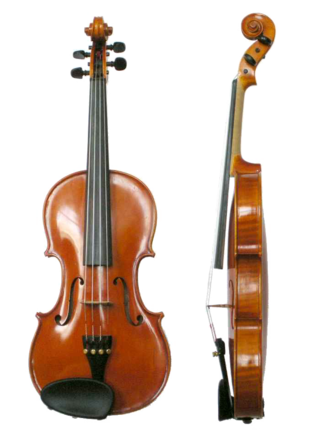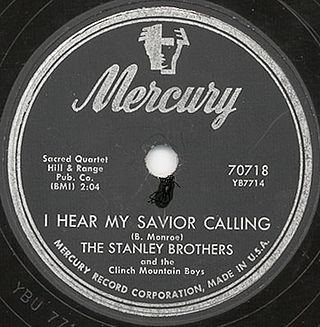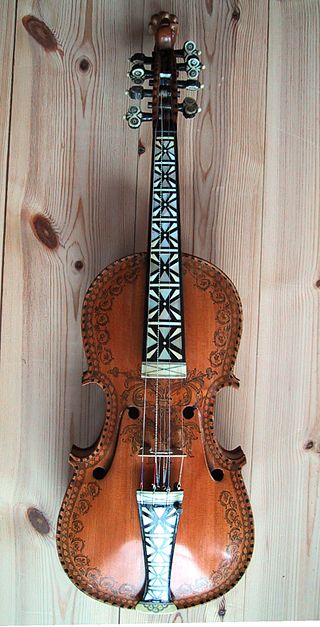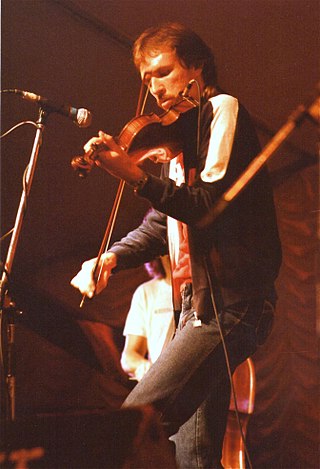Related Research Articles

A fiddle is a bowed string musical instrument, most often a violin. It is a colloquial term for the violin, used by players in all genres, including classical music. Although in many cases violins and fiddles are essentially synonymous, the style of the music played may determine specific construction differences between fiddles and classical violins. For example, fiddles may optionally be set up with a bridge with a flatter arch to reduce the range of bow-arm motion needed for techniques such as the double shuffle, a form of bariolage involving rapid alternation between pairs of adjacent strings. To produce a "brighter" tone than the deep tones of gut or synthetic core strings, fiddlers often use steel strings. The fiddle is part of many traditional (folk) styles, which are typically aural traditions—taught "by ear" rather than via written music.

The violin, sometimes referred as a fiddle, is a wooden chordophone, and is the smallest, and thus highest-pitched instrument (soprano) in regular use in the violin family. Smaller violin-type instruments exist, including the violino piccolo and the pochette, but these are virtually unused. Most violins have a hollow wooden body, and commonly have four strings, usually tuned in perfect fifths with notes G3, D4, A4, E5, and are most commonly played by drawing a bow across the strings. The violin can also be played by plucking the strings with the fingers (pizzicato) and, in specialized cases, by striking the strings with the wooden side of the bow.

The hurdy-gurdy is a string instrument that produces sound by a hand-crank-turned, rosined wheel rubbing against the strings. The wheel functions much like a violin bow, and single notes played on the instrument sound similar to those of a violin. Melodies are played on a keyboard that presses tangents—small wedges, typically made of wood or metal—against one or more of the strings to change their pitch. Like most other acoustic stringed instruments, it has a sound board and hollow cavity to make the vibration of the strings audible.

The Stanley Brothers were an American bluegrass duo of singer-songwriters and musicians, made up of brothers Carter Stanley and Ralph Stanley. Ralph and Carter performed as The Stanley Brothers with their band, The Clinch Mountain Boys, from 1946 to 1966. Ralph kept the band name when he continued as a solo artist after Carter's death, from 1967 until his own death in 2016.

The morin khuur, also known as the horsehead fiddle, is a traditional Mongolian bowed stringed instrument. It is one of the most important musical instruments of the Mongol people, and is considered a symbol of the nation of Mongolia. The morin khuur is one of the Masterpieces of the Oral and Intangible Heritage of Humanity identified by UNESCO.

The erhu is a Chinese two-stringed bowed musical instrument, more specifically a spike fiddle, which may also be called a southern fiddle, and is sometimes known in the Western world as the Chinese violin or a Chinese two-stringed fiddle.

A Hardanger fiddle is a traditional stringed instrument considered to be the national instrument of Norway. In modern designs, this type of fiddle is very similar to the violin, though with eight or nine strings and thinner wood. The earliest known example of the hardingfele is from 1651, made by Ole Jonsen Jaastad in Hardanger, Norway. Originally, the instrument had a rounder, narrower body. Around the year 1850, the modern layout with a body much like the violin became the norm.

Old-time music is a genre of North American folk music. It developed along with various North American folk dances, such as square dancing, contra dance, clogging, and buck dancing. It is played on acoustic instruments, generally centering on a combination of fiddle and plucked string instruments, most often the banjo, guitar, and mandolin. Together, they form an ensemble called the string band, which along with the simple banjo-fiddle duet have historically been the most common configurations to play old-time music. The genre is considered a precursor to modern country music.

Strait Out of the Box is the first box set album by American country music artist George Strait. It contains four albums' worth of music, dating from 1976 to 1995. It mainly consists of Strait's singles, except for a select few that he decided to exclude. They were replaced by his choice of album cuts and several studio outtakes. It also contains his three singles recorded in the 1970s for indie label D Records, one of which, "I Just Can't Go on Dying Like This", was re-recorded for Strait's 2013 album Love Is Everything.

Mark O'Connor is an American fiddle player, composer, guitarist, and mandolinist whose music combines bluegrass, country, jazz and classical. A three-time Grammy Award winner, he has won six Country Music Association Musician Of The Year awards and was a member of three influential musical ensembles: the David Grisman Quintet, The Dregs, and Strength in Numbers.
Old & In the Way was a bluegrass group formed in 1973. It was composed of Peter Rowan, Vassar Clements (fiddle), Jerry Garcia, David Grisman, and John Kahn. When the group was forming, it was intended that John Hartford would be the fiddle player. Based on Hartford's engagements, and Clements' reputational stature in the bluegrass community, Clements became the group's fiddler.
The musical traditions of Central Asia mirror the immense diversity found in the cultures and populations residing in the region. Principal instrument types are two- or three-stringed lutes, the necks either fretted or fretless; fiddles made of horsehair; flutes, mostly sige at both ends and either end-blown or side-blown; and jew harps, mostly metal. Percussion instruments include frame drums, Tam origin of the bowed string Use of the bowed string is thought to originate with nomads who mainly used the snake-skin, covered horsetail-bowed lute. In Mongolia instruments like the morin khuur or horse-head fiddle survive today.

The rebab is the name of several related string instruments that independently spread via Islamic trading routes over much of North Africa, Middle East, Central Asia, Southeast Asia, and parts of Europe. The instrument is typically bowed, but is sometimes plucked. It is one of the earliest known bowed instruments, named no later than the 8th century, and is the parent of many bowed and stringed instruments.
A string band is an old-time music or jazz ensemble made up mainly or solely of string instruments. String bands were popular in the 1920s and 1930s, and are among the forerunners of modern country music and bluegrass. While being active countrywide, in Philadelphia and its surrounding suburbs they are a huge part of its musical culture and traditions, appearing, among others, in the yearly Mummers Parade.

The tro is Cambodia's traditional spike fiddle, a bowed string instrument that is held and played vertically. Spike fiddles have a handle that passes through the resonator, often forming a spike, on the bottom side where it emerges. The family is similar or distantly related to the Chinese erhu or huqin. The instruments have a soundbox at the bottom of the stick, covered with leather or snake skin. Strings run from pegs at the top of the stick and secured at the bottom, running across the soundbox. The larger the soundbox, the lower the pitch range. Instruments in this family include the two-stringed tro ou, tro sau thom, tro sau toch and tro che, as well as the three-stringed tro Khmer spike fiddle. The two-stringed tros are tuned in a fifth, while the three-stringed tro Khmer is tuned in fourths. The tros, with the exception of the tro Khmer, are strung so that the bowstring is permanently placed between the two stings. When the musician plays, the placement of the bow causes the strings to be played at once, one from below and one from above. In contrast, western fiddles are played with the bow pushing on each string from the outside, as is also the case with the tro khmer.

The saw sam sai is a traditional bowed string instrument of Thailand. It is in the saw family of Thai fiddles, which also includes the saw u and saw duang, but unlike the other two, it has three strings and a bow that is separate from the instrument.

The bladder fiddle was a folk instrument used throughout Europe and in the Americas. The instrument was originally a simple large stringed fiddle made with a long stick, one or more thick gut strings, and a pig's-bladder resonator. It was bowed with either a notched stick or a horsehair bow.
Theron Evan Hale was an American old-time fiddle and banjo player. He was a member of the Grand Ole Opry in the late 1920s and 1930s, and is often remembered as a more laid back and sedate alternative to the raucous dance and "hoedown" music that dominated the Opry in its early days. Hale continued playing and recording until the late 1940s, often accompanied by Opry guitarist Sam McGee.
The cornstalk fiddle is a toy, and a type of bowed string instrument played historically in North America. The instrument consists of a cornstalk, with slits cut into the shaft to allow one or more fibrous sections to separate from the main body and serve as "strings." Pieces of wood or other material are wedged under the strings before they rejoin the body to serve as a nut and bridge.

The Apache fiddle is a bowed string instrument used by the indigenous Apache people of the southwestern United States. The instrument consists of a plant stalk, such as that of the agave or mescal plant. One or sometimes two strings, often made of horse hair, are secured at both ends of the stalk, a bridge and nut added, and the string is played with a bow resined with pine pitch. The string is touched with the fingers to change its note. The Smithsonian Institution holds an Apache fiddle collected in 1875. In 1989 Apache fiddle maker Chesley Goseyun Wilson of Tucson, Arizona won a National Heritage Award.
References
- ↑ Mark Nuttall (2005). Encyclopedia of the Arctic. Routledge. p. 1582. ISBN 978-1-57958-439-9 . Retrieved 9 June 2012.